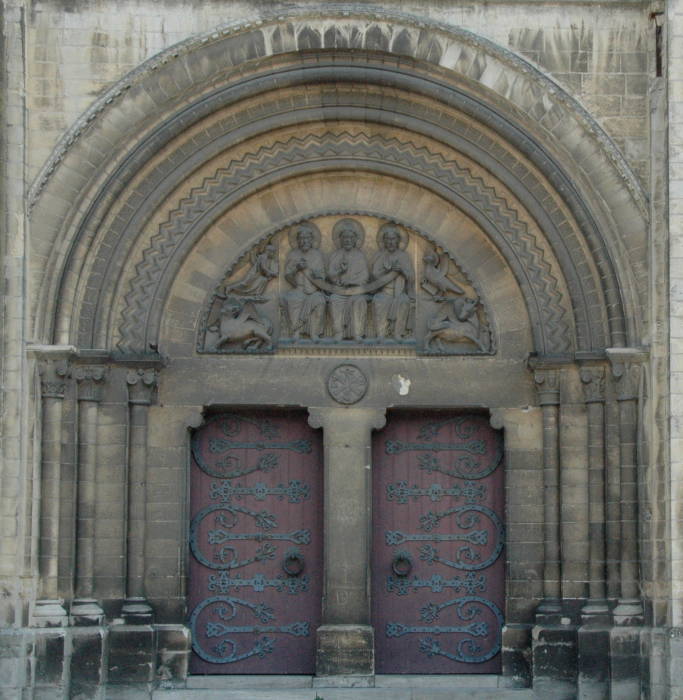France exhibits several varieties of the Romanesque style, in which peculiarities are traceable, and for this reason it may be divided into southern and northern provinces, the main dividing line being the Loire.
Plans

Naves vaulted in square bays (Plate 100).
In the south, internal buttresses, inclosing the outer range of chapels, were preferred, as at Vienne cathedral. Round churches are rare in this district. Towers are detached. resembling Italian campanili. Cloisters were treated with the utmost elaboration and richness, usually having double columns with magnificent capitals which receive the round arches of the narrow bays, and were left entirely open, as glazing or tracery were not required by the climate.
In the north, the increasing demand for vaulted interiors modified the planning, and the vaulting ribs were provided witli individual shafts, which developed the pier plans. In the setting out of the bays important changes were introduced, thus in early plans the naves were vaulted in square bays comprising two aisle bays longitudinally (No. 100), but on the introduction of the pointed arch each oblong bay of the nave formed a vaulting compartiment corresponding in length to each aisle bay.
Walls
Massiveness is the characteristic of all the early work. Walls were of rubble with facing stones. Elaboration was reserved for doorways in the arcadcd lower portion of the facades, which are often models of simplicity and richness. Buttresses are often mere strips of slight projection (No. 99).

West Front, the Abbaye-aux-Dames, Caen. Plate 99. [more photographs. Click on image to enlarge it.]
The facades were arranged in stories, with window liglits in pairs or groups. Flying buttresses, admitting of high clerestories with windows lighting the nave, were introduced between A.D. 1150-1200. The towers are mostly square with pyramidal roofs (Nos. 99 and 101).



Left: (a) East End, the Abbaye-aux-Hommes (S. Ettienne), Caen. (b) View from inside the cloisters. (c) View through the cloisters. [Click on these images for larger pictures.]
Openings
The earlier vaulted churches have no clerestory. In the south, narrow openings with wide splays to admit light sufficed, while in the north a commencement in grouping was made, more especially in the direction of filling in the vault spandrels of the clerestory with arrangements of three and five light openings. The ante-chapels at the Church at Vézelay (1130) are generally referred to as having the earliest pointed vaults in France. Imposing western entrances are characteristic of this period.



Interior and exterior doorways and arches in he Abbaye-aux-Dame, Caen. [Click on these images for larger pictures.]
Roofs
In the south, the early treatment was a tunnel vault to the nave, buttressed by half tunnels over the aisles, often in two stories, thus not admitting of a clerestory. The pointed section was sometimes used, doubtless to lessen the thrust upon the walls, and in order that the roofing slabs of stone might be carried direct upon the extrados of the vault. In the north, clerestories of increased height were obtained by means of the intersecting nave vaults (No. 100), with groin ribs (introduced in the twelfth century), whose thrust was taken by buttress arches concealed in the aisle roofs—a step towards the later living buttresses. The vault in the southern examples frequently supports the roofing slabs direct, while in the northern examples above the stone vault were constructed wooden roofs, which supported the covering independent of the vault.
Columns
In nave arcades, either square piers, recessed in planes, and having upon their faces half round shafts carried up to the vaulting ribs (No. 103 M-P), were employed, or columns, circular or octagonal, and reminiscent of Roman times, were used, and then tlie vaulting shafts start awkwardly from the abacus of their huge capitals (No. 103 D, E), imitated from the Corinthian order. The carrying up of the vaulting shafts emphasizes the division of the nave into bays.


Left to right: (a) French Romanesque Ornament (Plate 103). (b) Capitals, Abbaye aux Dames, Caen. [Click on these images for larger pictures.]
Mouldings
In the south, the elegance due to classic tradition contrasts with the rough axed decoration cut upon the structural features of the Norman work. In the latter, arched jambs are formed in recessed planes (No. 102), with nook shafts plainly fluted, or cut with zigzags.

Porch, S.Trophîme, Arles (Plate 102)
Capitals are cubical blocks, either plain or carved with copies of acanthus leaves from old Roman examples (No. 103). Corbel tables, supported by plain blocks or grotesque heads, form the cornices of the walls (No. 103 B, G, J).
Ornament
Painted glass was not favoured in southern examples, small, clear-glazed openings beiny employed to set off the opaque decoration of the walls. Stained glass favouring large openings was gradually developed in the north. The diaper work so common in the spandrels of arches, in northern work is supposed to have arisen from the imitation, in carving, of the color pattern work, or draperies that originally occupied the same positions.
References
Fletcher, Banister, and Banister F. Fletcher. A History of Architecture on the Comparative Method for the Student, Craftsman, and Amateur. 5th ed. London: B. T. Batsford, 1905.
Last modified 9 March 2014